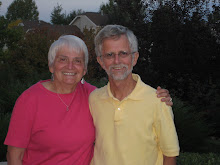We started on the Cottonwood Trail. There are 7 miles of the Red Deer River that are protected by the Park and along this river grow many cottonwood trees. There are some that have been here for several hundred years and have gotten huge!The tree above is thought to be over 200 years old. It was likely a sapling when the first white man arrived in Alberta. The Plains Indians respected the spirit of ancient looking trees like this and used them as burial places placing their dead on platforms in these trees.
The thick bark of the cottonwood helps it retain water.
There was a fire that went through here and the shrubby regrowth
attract mule deer. We saw 8 this morning.
Then down to the Red Deer River
Back to the frosty and wet tent for a quick breakfast.
Then to the Badlands section. These are hoodoos. They begin to form where sandstone with a hard ironstone lay begin to erode. The soft material on the top of the ironstone erodes and leaves a ledge. Erosion enlarges soft joints between the blocks of ironstone, creating separate pillars. Each pillar is left as a hoodoo with an ironstone cap protecting the soft sandstone underneath. Erosion undermines the cap until it fall off. With the cap removed the hoodoo pillar quickly erodes to ground level.
Erosion area.
an overlook to the Red Deer River and cottonwoods & aspens.
another mule deer.
Time for a quick lunch and then off for our Interpretive Tour. We met at the Visitor's Center and all got on a 24 seater bus and headed for the Research area of the Park. Brian was our guide. The majority of the Park is restricted to Research personnel with only a small section for open hiking and wandering by the public. These tours go into the research area so you can explore a little.
Hoodoo
Dinosaur territory down there.
major hoodoo
This brass marker indicates a dinosaur skeleton was found here.
A BONE!
A fossil of a plant.
This was a cast that had been made over a bone so it could be moved.
Death pose of dinosaur.
Dinosaur jar and teeth.
As found.
Heading back...one lone aspen among the grasses.
Oops - unexpected stop as a rattlesnake crosses the road.
It was an awesome tour and Brian was terrific! Great personality and you could tell he loved his work! We had several smaller kids and he was great with them too! Highly recommend this trip! When we got back he answered a few more questions and then we headed back to the campground. It was a beautiful afternoon so did a little more wandering around here and came upon this...
The John Ware Cabin.
I found his story fascinating so am including an article from Wikipedia at the end of this entry.
Headed back and had dinner and then we had
this wonderful sunset. Perfect end to a super day!!
John Ware (1845 – 12 September 1905) was an African-American and later Black Canadian cowboy, best remembered for his ability to ride and train horses and for bringing the first cattle to southern Alberts in 1882, helping to create that province's important ranching industry. Ware was born into slavery in South Carolina. After the Civil War he left the Carolinas for Texas where he learned the skills of a rancher and became a cowboy. Ware's great stature and dedication to hard work made him a natural and allowed him to work his way up to Canada driving cattle from Texas to Montana and then into the great plains that would eventually become Alberta. Upon his arrival in Calgary he found work at the Bar U and Quorn ranches before starting his own ranch near the Red Deer river.
By 1900, he and his wife, Mildred, had five children. He moved from the Calgary area to a spot northeast of the village of Dutchess, Alberta. In 1902 his first home was destroyed by the spring flood. He rebuilt on higher ground overlooking a stream, now called Ware Creek. Three years later Mildred died of pneumonia in the spring; despite being a master horseman John was killed in the fall when his horse tripped in a badger hole crushing its rider and breaking his neck. Ware's funeral was reported to be one of the largest held in the early days of Calgary. The story of John Ware is that of a remarkable figure in history who helped to lay the foundations of the ranching industry in western Canada and at the same time defying stereotypes. Born a slave, Ware worked his way to being one of the most well-respected figures in frontier Alberta, crossing race lines thanks to his good nature and hard work.





























